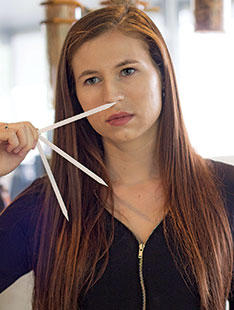Miranda Gordon ’91 and Dana Schmitt ’12: Sweet-Smelling Careers
With finely honed olfactory skills, Princetonians plunge into the perfume industry
If you think gaining admission to Princeton is daunting, try getting into the Givaudan Perfumery School on the outskirts of Paris. In 2014, Dana Schmitt ’12 was one of three chosen from roughly 1,000 applications for a coveted position at the school. The commitment is also impressive: four years of study followed by at least five of employment with Givaudan, the world’s biggest company specializing in fragrance and flavor.
As a Princeton junior, Schmitt stumbled upon the Fragonard perfume museum on a visit to Paris. The docent explained that a perfumer needs an understanding of chemistry, creativity, and a good nose. Schmitt, a chemistry major who painted and played piano, aced the museum’s smell test and thought, “Voilà! That’s what I want to do.”
At the start of perfumery school, Schmitt memorized 150 natural and 350 synthetic smells in batches, taking notes to herself such as “cylomethylene citronellol — smells like dill.” She was regularly tested on 20 chosen at random. After six months, failure to identify nearly all 500 could have meant dismissal.
READ MORE Chris Palmer '82: ‘Fragrance Is All About Nostalgia’
Next she studied accords (combinations of three to six materials) and started replicating skeletons of existing perfumes, starting with 16 raw materials and combining up to 60 (which create simplified versions of the perfumes). This year, she is apprenticing in Givaudan offices in Switzerland and Singapore. And when she returns to Paris, she’ll start creating her own signature perfumes and collaborating on “real-world” projects for Givaudan.
Miranda Gordon ’91, vice president of marketing for fine fragrances with MANE (a French company and a major player in flavor and fragrance) based in New York City, is another rare Tiger in the industry. At her 25th reunion, she identified a classmate’s Kenzo fragrance and explained that they were “smelling an ionone signature, where violets overlap with raspberries and orris, the dried and aged rhizome, of the Florentine iris.” She called the fragrance, with quiet florals on top of vanilla and musk, a good fit for Reunions, because “it’s a hug-me kind of scent.”
“The only real way to train is to smell all the time,” she says. “On my desk there are at least 100 bottles, with seven blotters active at any given time with raw materials and current projects.”
Raised in Hawaii, Gordon enjoyed a very “olfactive childhood.” She describes her favorite tropical flower, the puakenikeni, as smelling like “gardenia plus yellow cake batter.” At Princeton, she studied classics, French, Spanish, Italian, and art history, and spent a semester in Rome. She later worked at Christie’s, in retail, and in TV, until she went to Columbia Business School, where a career adviser asked her, “What section of The New York Times do you read first?” She admitted she liked the perfume launches in the Styles of the Times section. He advised her projects on the industry, and she graduated to jobs at Avon, Givaudan, and Firmenich before arriving at MANE, helping clients understand where a product comes from and why it’s right for their brand and their target customer. She advises on packaging, names, and general strategy.
“Twenty years ago, my job was just to get clients to buy the fragrance; today, marketers are expected to provide industry insights and consulting services, which build trust,” Gordon says.

Making a perfume is not like tossing a salad. You cannot throw ingredients together willy-nilly. It must work at the molecular level. Gordon explains, for example, that cassis and rhubarb combined smell like “cat urine on marijuana.” At one point, perfumers she worked with created a delicate molecule redolent of flowers which, when mixed with anything else, smelled like fish.
Aromas have a cultural component: Fenugreek absolute reminds Schmitt of New England maple syrup. Her classmate from Brazil perceives it as overripe papaya. Where Americans smell grape, as in cough syrup, the French smell orange blossom. And there’s a nostalgic component: Mineral and mossy aromas bring Gordon back to the steps of Blair Arch. A year ago, Gordon married Myles Derieg ’92 at a lavender farm in Hawaii, carrying a bouquet of fragrant herbs.
Partway through her schooling, Schmitt already smells the world differently. “I was running in Central Park, the same path that I’d run for two years, and I smelled the lake very strongly. That was new!” It’s a challenging and unusual student life, but one that comes with perks: Givaudan pays for her apartment in Paris and even gives her a small stipend. She calls it “dreamland. I have to pinch myself sometimes.”












No responses yet